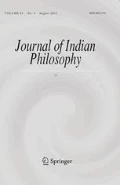Abstract
This paper examines the Buddhist’s answer to one of the most famous (and more intuitive) objections against the semantic theory of “exclusion” (apoha), namely, the charge of circularity. If the understanding of X is not reached positively, but X is understood via the exclusion of non-X, the Buddhist nominalist is facing a problem of circularity, for the understanding of X would depend on that of non-X, which, in turn, depends on that of X. I distinguish in this paper two strategies aiming at “breaking the circle”: (i) conceding the precedence of a positive understanding of X, from which a negative understanding (i.e., the understanding of “non-X”) is derived by contrast, and (ii) denying any precedence by proposing a simultaneous understanding of both X and non-X. I consider how these two options are articulated respectively by Dharmakīrti in his Pramāṇavārttika cum Svavṛtti and by one of his Tibetan interpreters, Sa skya Paṇḍita, and examine the requirements for their workability. I suggest that Sa skya Paṇḍita’s motivation to opt for an alternative solution has to do with his criticism of notions shared by his Tibetan predecessors, an outline of which is given in Appendix 1. In Appendix 2, I present the surprising use of the charge of circularity by an early Tibetan logician against his coreligionists.
Similar content being viewed by others
References
Apothéloz, D., Brandt, P.-Y., & Quiroz, G. (1989). De la logique à la contre-argumentation. In La Négation. Contre-argumentation et contradiction. Travaux du Centre de Recherches Sémiologiques (Université de Neuchâtel), 57, 1–42.
Arnold D. (2006) On semantics and sam: keta: Thoughts on a neglected problem with Buddhist apoha doctrine. Journal of Indian Philosophy 34: 415–478
Dreyfus G. (1997) Recognizing reality. Dharmakīrti’s philosophy and its Tibetan interpretations. State University of New York Press, Albany, NY
Dunne J. (2004) Foundations of Dharmakīrti’s philosophy. Widsom Publications, Boston.
Gnoli, R. (Ed.). (1960). The Pramāṇavārttikam of Dharmakīrti: The first chapter with the autocommentary: Text and critical notes. Serie Orientale Roma, XXIII. Rome: Istituto Italiano per il Medio ed Estremo Oriente.
Hayes R. (1988) Dignāga on the interpretation of signs. Reidel, Dordrecht
Hugon, P. (Ed.). (2004). mTshur ston gZhon nu seng ge. Tshad ma shes rab sgron ma. Wiener Studien zur Tibetologie und Buddhismuskunde 60. Vienna: Arbeitskreis für tibetische und buddhistische Studien.
Hugon, P. (2008a). Trésors du raisonnement, Sa skya Paṇḍita et ses prédécesseurs tibétains sur les modes de fonctionnement de la pensée et le fondement de l’inférence. Edition et traduction annotée du quatrième chapitre et d’une section du dixième chapitre du Tshad ma rigs pa’i gter. Wiener Studien zur Tibetologie und Buddhismuskunde 69.1 and 69.2. Vienna: Arbeitskreis für tibetische und buddhistische Studien.
Hugon, P. (2008b). Arguments by parallels in the epistemological works of Phya pa Chos kyi seng ge. Argumentation, 22.1, 93–114. doi:10.1007/s10503-007-9074-7
Hugon, P. (forthcoming). Dharmakīrti’s discussion of circularity. In A. Chakrabarti, M. Siderits, & T. Tillemans, (Eds.), Proceedings of the conference on apoha semantics and human cognition May 24–28, 2006, Crêt-Bérard, Switzerland.
Katsura S. (1979) The apoha theory of Dignāga. Indo-Bukkyō Kenkyū (Journal of Indian and Buddhist Studies 28(1): 489–493
Kellner, B. (2004). Why infer and not just look? Dharmakīrti on the psychology of inferential process. In S. Katsura, & E. Steinkellner, (Eds.), The role of the example (dṛṣṭānta) in classical indian logic (pp. 1–51). Wiener Studien zur Tibetologie und Buddhismuskunde 58. Vienna: Arbeitskreis für tibetische und buddhistische Studien.
Much, M. T. (1993). Indian Buddhist semantics in the 7th century A.D. Dharmakīrti’s theory of ‘exclusion’ (apoha). Semiotische Berichte, 3/4, 323–330.
Much, M. T. (1994). Uddyotakaras Kritik der Apoha-Lehre (Nyāyavārttika ad NS II,66). Wiener Zeitschrift für die Kunde Südasiens, 38, 351–366.
Nor brang o rgyan, (Ed.). (1989). Tshad ma rigs pa’i gter gyi rang gi ’grel pa. Lhasa: Bod ljongs mi dmangs dpe skrun khang.
Nyaya-Tarkatirtha, T., Tarkatirtha, A., & Tarkatirtha, H. (Eds.). (1982). Nyāyadarśanam. With Vātsyāyana’s Bhāṣya, Uddyotakara’s Vārttika, Vācaspati Miśra’s Tātparyaṭīkā & Viśvanātha’s Vṛtti. (2 Vols.) Kyoto: Rinsen Book Co. [First ed. Calcutta, 1936–1944].
Pradhan P. (eds) (1967) Abhidharmakośabhāṣya of Vasubandhu. Kashi Prasad Jayaswal Research Institute, Patna
Siderits, M. (forthcoming). Śrughna by dusk. In A. Chakrabarti, M. Siderits, & T. Tillemans, (Eds.), Proceedings of the conference on apoha semantics and human cognition May 24–28, 2006, Crêt-Bérard, Switzerland.
Steinkellner, E. (Ed.). (2007). Dharmakīrti’s Pramāṇaviniścayaḥ, Chapters 1 and 2. Sanskrit texts from the Tibetan autonomous region No. 2. Beijing-Vienna: China Tibetology Publishing House/Austrian Academy of Sciences Press.
Stoltz J. (2006) Sakya Paṇḍita and the status of concepts. Philosophy East and West 56(4): 567–582
Śāstri, S.D. (Ed.). (1978). Ślokavārttika of Śrī Kumārila Bhaṭṭa. With the commentary Nyāyaratnākara of Śrī Pārthasārathi Miśra. Prāchyabhārati Series 10. Varanasi: Tara Publications.
Author information
Authors and Affiliations
Corresponding author
Rights and permissions
About this article
Cite this article
Hugon, P. Breaking the Circle. Dharmakīrti’s Response to the Charge of Circularity Against the Apoha Theory and its Tibetan Adaptation. J Indian Philos 37, 533–557 (2009). https://doi.org/10.1007/s10781-009-9077-9
Published:
Issue Date:
DOI: https://doi.org/10.1007/s10781-009-9077-9




